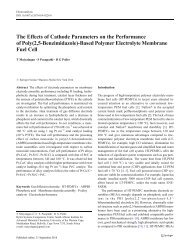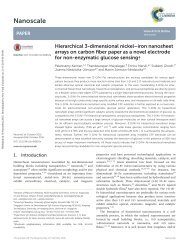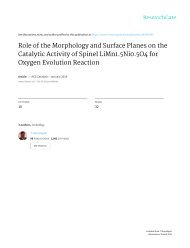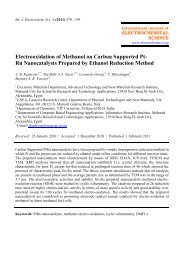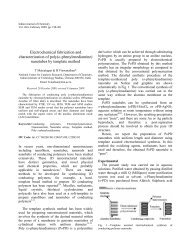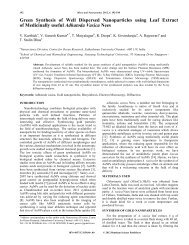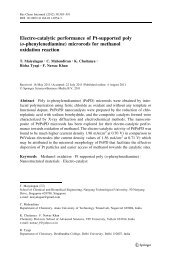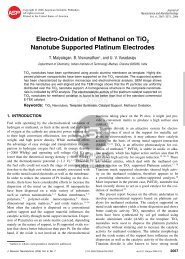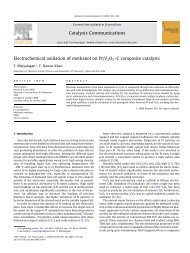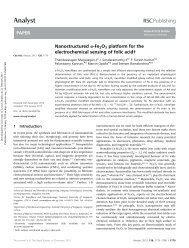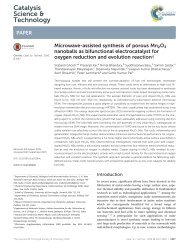Fabrication, morphology and structural characterization of tungsten oxide nanorods
Create successful ePaper yourself
Turn your PDF publications into a flip-book with our unique Google optimized e-Paper software.
Full Paper<br />
<strong>Fabrication</strong>, <strong>morphology</strong> <strong>and</strong> <strong>structural</strong> <strong>characterization</strong> <strong>of</strong><br />
<strong>tungsten</strong> <strong>oxide</strong> <strong>nanorods</strong><br />
T.Maiyalagan, B.Viswanathan*<br />
National Center for Catalysis Research, Department <strong>of</strong> Chemistry, Indian Institute <strong>of</strong> Technology Madras,<br />
Chennai 600 036, (INDIA)<br />
Phone : +91-044-22574200 ; Fax: +91-44-22574202<br />
E-mail : bvnathan@iitm.ac.in<br />
Received: 1 st September, 2007 ; Accepted: 6 th September, 2007<br />
ABSTRACT<br />
The Template synthesis <strong>of</strong> Tungsten <strong>oxide</strong> <strong>nanorods</strong> by calcination <strong>of</strong><br />
Phosphotungtstic acid (HPW) on alumina membrane template is described.<br />
The <strong>nanorods</strong> were characterized by electron microscopic analyses, Raman,<br />
IR <strong>and</strong> X-ray diffraction techniques. SEM, TEM <strong>and</strong> AFM images reveal the<br />
hollow structures <strong>and</strong> vertically aligned features <strong>of</strong> the nanotubes <strong>and</strong> the<br />
phase structure <strong>of</strong> the WO 3<br />
was proved by X-ray diffraction. In addition, it<br />
is observed that the cycle ability <strong>of</strong> the <strong>nanorods</strong> is superior to that <strong>of</strong> bulk<br />
materials, which implies that the <strong>morphology</strong> has an influence on the electrochemical<br />
performances <strong>of</strong> the material.<br />
2007 Trade Science Inc. - INDIA<br />
KEYWORDS<br />
Tungsten <strong>oxide</strong> <strong>nanorods</strong>;<br />
Template synthesis;<br />
Alumina template.<br />
INTRODUCTION<br />
There is great interest in the synthesis <strong>of</strong> one-dimensional<br />
nanostructured materials because <strong>of</strong> its potential<br />
applications in many areas. Metal-<strong>oxide</strong> semiconductors<br />
such as WO 3<br />
, TiO 2<br />
, <strong>and</strong> ZnO <strong>and</strong> SnO 2<br />
are widely used in sensors, having high detection ability<br />
<strong>and</strong> stability [1–3] . These transition metal <strong>oxide</strong>s have<br />
drawn much attention from scientists in recent years<br />
because they are applied as electrochromic materials.<br />
Their potential applications include several technological<br />
areas. Tungsten metal, <strong>tungsten</strong> <strong>oxide</strong>s <strong>and</strong> tungstates<br />
represent a fascinating class <strong>of</strong> materials. Tungsten<br />
wires/filaments are widely used as tips for field<br />
emission <strong>and</strong> tips for scanning tunneling microscopy [4] .<br />
The rich <strong>structural</strong> chemistry <strong>of</strong> <strong>tungsten</strong> <strong>oxide</strong>s encompasses<br />
a multitude <strong>of</strong> interesting compounds <strong>and</strong> a wide<br />
spectrum <strong>of</strong> tungstic acids <strong>and</strong> different WO 3<br />
phases.<br />
Tungsten <strong>oxide</strong> is an important functional material. In<br />
recent years, a variety <strong>of</strong> nanometer-scaled structures<br />
<strong>of</strong> <strong>tungsten</strong> <strong>oxide</strong> have been developed. These nano<br />
structures have demonstrated promising properties. To<br />
date, WO 3<br />
has been one <strong>of</strong> the most extensively studied<br />
materials for its Electrochromic, photochromic <strong>and</strong><br />
thermo chromic properties for use in devices, such as<br />
information displays, sensor devices <strong>and</strong> smart Windows.<br />
In addition, WO 3<br />
has a high potential for use in<br />
electrochemical devices, such as rechargeable lithium<br />
batteries, owing to its rich chemical intercalation reactivity.<br />
The <strong>oxide</strong>s <strong>of</strong> transition metal <strong>tungsten</strong> have at-
2 Tungsten <strong>oxide</strong> . <strong>nanorods</strong><br />
Full Paper<br />
tracted constant research interest for the past few decades<br />
due to their wide applicability as gas sensors for<br />
SO 2<br />
<strong>and</strong> H 2<br />
S [5,6] , as excellent field emitters(specifically<br />
W 18<br />
O 49<br />
) [7] <strong>and</strong> as photo anodes in photochemical<br />
cells [8] . In addition, WOx have also found unique application<br />
in electro chromic devices due to their excellent<br />
voltage-modulated optical properties [9] . Tungsten<br />
<strong>oxide</strong>(WO 3<br />
) is an n-type semiconductor with a reported<br />
b<strong>and</strong> gap <strong>of</strong> about 2.6-2.8eV [10] . The intrinsic conductivity<br />
arises from its non-stoichiometric compositiongiving<br />
rise to a donor level formed by oxygen vacancy<br />
defect in the lattice. Since <strong>tungsten</strong> has many oxidation<br />
states, i.e., 2, 3, 4, 5 <strong>and</strong> 6, the <strong>tungsten</strong> compound can<br />
exist in many forms. For instance, the typical forms <strong>of</strong><br />
<strong>tungsten</strong> <strong>oxide</strong>s are <strong>tungsten</strong>(VI) <strong>oxide</strong>(WO 3<br />
, lemon<br />
yellow appearance) <strong>and</strong> <strong>tungsten</strong>(IV) <strong>oxide</strong>(WO 2<br />
,<br />
brown <strong>and</strong> blue appearance) [11] . Such electronic properties<br />
make the <strong>tungsten</strong> <strong>oxide</strong>s suitable for various applications<br />
such as electrochromic [12] , photochromic [13] ,<br />
photocatalyst [14] , <strong>and</strong> gas sensors [15-17] . Various methods<br />
including chemical vapour deposition [18] , electrochemical<br />
deposition [19] , laser vaporization [20, 21] have<br />
been used to prepare <strong>tungsten</strong> <strong>oxide</strong> thin films. In conventional<br />
WO 3<br />
thin films with nanoscale-sized grains,<br />
the electrical conduction is mainly controlled by free<br />
carrier transport across the grain boundaries. So the<br />
synthesis <strong>of</strong> mono crystalline <strong>tungsten</strong> <strong>oxide</strong> as nano<br />
wires or <strong>nanorods</strong> is <strong>of</strong> great interest. In the past years,<br />
Zhu et al. [22] produced a micrometer scale tree-like structure<br />
by heating a <strong>tungsten</strong> foil, partly covered by SiO 2<br />
in Ar atmosphere at 1600 0 C. These nanostructures were<br />
composed by monoclinic W 18<br />
O 49<br />
nanoneedles <strong>and</strong> WO3<br />
nanoparticles. Nanorods <strong>of</strong> several <strong>oxide</strong>s including<br />
WO 3<br />
have been prepared by templating on acid-treated<br />
carbon nanotubes [23] . By heating WS 2<br />
in oxygen, fibers<br />
<strong>of</strong> W 18<br />
O 49<br />
were produced with a pine-treelike structure<br />
[24] . Mixtures <strong>of</strong> WO 2<br />
<strong>and</strong> WO 3<br />
with <strong>nanorods</strong><br />
structure were obtained by Koltypin et al. [25] via amorphous<br />
<strong>tungsten</strong> <strong>oxide</strong> nanoparticles. Li et al. [26] have<br />
synthesized WO 3<br />
nanobelts <strong>and</strong> <strong>nanorods</strong> via physical<br />
vapour deposition process where the nanostructures<br />
were deposited on silicium wafers maintained at 600 0 C.<br />
Recently Liu et al. [27] reported on the preparation <strong>of</strong><br />
<strong>tungsten</strong> <strong>oxide</strong> nanowires through a vapour-solid growth<br />
process by heating a <strong>tungsten</strong> wire partially wrapped<br />
with boron <strong>oxide</strong> at 1200 0 C <strong>and</strong> Shingaya et al. [28] prepared<br />
by oxidation at high temperature well-oriented<br />
WOx <strong>nanorods</strong> on a(0. 01)W surface.<br />
However, the study on nanoscaled WO 3<br />
materials<br />
is still in its infancy due to lack <strong>of</strong> suitable preparation<br />
method. In the present work, we report a novel route<br />
for template synthesis <strong>of</strong> crystalline WO 3<br />
<strong>nanorods</strong>. Our<br />
work on the <strong>tungsten</strong> <strong>oxide</strong> tubular structures featured<br />
a low cost <strong>and</strong> an easy manipulation technique. In the<br />
fabrication, no catalyst was involved <strong>and</strong> only a rough<br />
vacuum was required.<br />
Materials<br />
EXPERIMENTAL<br />
All the chemicals used were <strong>of</strong> analytical grade.<br />
Phosphotungstic acid(Sisco Research Laboratories,<br />
India), dichloromethane <strong>and</strong> concentrated HF(Merck)<br />
were used. Alumina template membranes were obtained<br />
from Whatman Anopore Filters. Anodisc alumina membranes<br />
with a pore size <strong>of</strong> 200nm <strong>and</strong> thickness <strong>of</strong> 60m<br />
were purchased from Whatman(catalog no. 6809-<br />
6022; Maidstone, U.K.).<br />
Synthesis <strong>of</strong> Tungsten <strong>oxide</strong> <strong>nanorods</strong>.<br />
10g <strong>of</strong> Phosphotungtstic acid(H 3<br />
PW 12<br />
O 40<br />
) was<br />
stirred in a 30ml <strong>of</strong> methanol solution. The resulting<br />
colloidal suspension was infiltrated into the membrane<br />
under vacuum by wetting method. The same procedure<br />
was repeated 1 to 8 times. The upper surface <strong>of</strong><br />
the membrane was then polished gently by s<strong>and</strong> paper(2500<br />
grit) <strong>and</strong> dried at 368 K for 1 h. The formation<br />
<strong>of</strong> WO 3<br />
<strong>nanorods</strong> inside alumina template(WO 3<br />
/<br />
AAO) was further achieved by programmed temperature<br />
thermal decomposition from 95 to 500 0 C min -1 <strong>and</strong><br />
finally calcinated at 873K for 3h in air. The removal <strong>of</strong><br />
the AAO template was performed by dissolving alumina<br />
template in 10%(v/v) HF. The WO 3<br />
nanorod product<br />
was washed with a copious amount <strong>of</strong> deionized<br />
water, to remove the residual HF <strong>and</strong> dried at 393 K.<br />
Characterization methods<br />
The scanning electron micrographs were obtained<br />
after the removal <strong>of</strong> alumina template using a JEOL<br />
JSM-840 model, working at 15keV. For transmission<br />
electron microscopic studies, the <strong>nanorods</strong> dispersed<br />
in ethanol were placed on the copper grid <strong>and</strong> the im-
Figure 1 : (a) SEM Micrograph <strong>of</strong> the WO 3<br />
nanorod <strong>and</strong> (b)<br />
AFM micrograph <strong>of</strong> the nanorod<br />
Figure 2 : (a) TEM Micrograph <strong>of</strong> the WO 3<br />
nanorod <strong>and</strong> (b)<br />
EDS pattern <strong>of</strong> nanorod<br />
I% Transmittance<br />
T.Maiyalagan <strong>and</strong> B.Viswanathan 3<br />
Full Paper<br />
temperature with 514.5nm excitation in backscattered<br />
mode using Bruker FRA106 FT-Raman instrument. The<br />
IR spectrum was recorded with Perkin-Elmer (L-710)<br />
spectrophotometer.<br />
Electrochemical measurements<br />
The catalyst was electrochemically characterized<br />
by cyclic voltammetry(CV) using an electrochemical<br />
analyzer(Bioanalytical Sciences, BAS 100). A common<br />
three-electrode electrochemical cell was used for the<br />
measurements. The counter <strong>and</strong> reference electrodes<br />
were a platinum plate(5cm 2 ) <strong>and</strong> a saturated Ag/AgCl<br />
electrode respectively. The CV experiments were performed<br />
using 1M H 2<br />
SO 4<br />
solution at a scan rate <strong>of</strong> 50<br />
mV/s. All the solutions were prepared by using ultra<br />
pure water (Millipore, 18M). The electrolytes were<br />
degassed with nitrogen before carrying out the electrochemical<br />
measurements.<br />
Preparation <strong>of</strong> working electrode<br />
Glassy carbon (GC) (BAS Electrode, 0.07cm 2 ) was<br />
polished to a mirror finish with 0.05m alumina suspensions<br />
before each experiment <strong>and</strong> this served as an<br />
underlying substrate <strong>of</strong> the working electrode. In order<br />
to prepare the composite electrode, the <strong>nanorods</strong> were<br />
dispersed ultrasonically in water at a concentration <strong>of</strong><br />
1mg ml -1 <strong>and</strong> 20l aliquot was transferred on to a polished<br />
glassy carbon substrate. After the evaporation <strong>of</strong><br />
water, the resulting thin catalyst film was covered with<br />
5-wt% Nafion solution. Then the electrode was dried<br />
at 353 K <strong>and</strong> used as the working electrode.<br />
Wave number(cm -1 )<br />
Figure 3 : FT-IR Spectrum <strong>of</strong> the (a) Calcined HPW (b)<br />
Bulk WO 3<br />
<strong>and</strong> (c) WO 3<br />
<strong>nanorods</strong><br />
ages were obtained using Phillips 420 model, operating<br />
at 120keV. The <strong>nanorods</strong> were sonicated in acetone<br />
for 20 minutes <strong>and</strong> then dropped on cleaned Si substrates.<br />
Next the AFM imaging was performed in air<br />
using a Nanoscope IIIA atomic force microscope (Digital<br />
Instruments, St. Barbara, CA) operated in contact<br />
mode.<br />
The X-ray diffraction patterns were obtained on a<br />
Philips PW1820 diffractometer with CuK á<br />
(1.54178 Å)<br />
radiation. The WO 3<br />
<strong>nanorods</strong> placed in glass capillary<br />
tubes were used for recording Raman spectrum at room<br />
RESULTS AND DISCUSSION<br />
The <strong>morphology</strong> <strong>of</strong> <strong>tungsten</strong> <strong>oxide</strong> <strong>nanorods</strong> was<br />
studied with SEM, AFM, transmission electron microscopy<br />
(TEM) images on a Philips CM12/STEM instrument.<br />
The scanning electron microscopy (SEM) image<br />
presented in figure 1(a) shows the rod like <strong>morphology</strong><br />
<strong>of</strong> the product. Further the AFM image confirms the<br />
rod like <strong>morphology</strong> in figure 1(b) which represents low<br />
magnification. The <strong>morphology</strong> <strong>of</strong> the <strong>nanorods</strong> can be<br />
confirmed with TEM micrograph shown in figure 2(a).<br />
The dimensions <strong>of</strong> the <strong>nanorods</strong> were matched with the<br />
outer diameter <strong>of</strong> the template used. The diameter <strong>of</strong><br />
the <strong>nanorods</strong> was found to be around 200nm.
4 Tungsten <strong>oxide</strong> . <strong>nanorods</strong><br />
Full Paper<br />
Intensity(a.u.)<br />
Current(mA)<br />
Potential(V)<br />
Raman shift (cm -1 )<br />
Figure 4 : Raman spectrum <strong>of</strong> the WO 3<br />
<strong>nanorods</strong><br />
Intensity(a.u.)<br />
20(degrees)<br />
Figure 5 : XRD patterns <strong>of</strong> (a) HPW <strong>and</strong> (b) WO 3<br />
<strong>nanorods</strong><br />
The composition <strong>of</strong> the <strong>nanorods</strong> was investigated<br />
using an energy dispersion spectroscopy (EDS). Figure<br />
2(b) shows EDS <strong>of</strong> the WO 3<br />
<strong>nanorods</strong>. EDS analysis<br />
indicates that the <strong>nanorods</strong> are mainly composed <strong>of</strong> W<br />
<strong>and</strong> O (the Cu signal comes from the TEM grids). No<br />
evidence <strong>of</strong> impurities was detected in the WO 3<br />
<strong>nanorods</strong>.<br />
The FT-IR spectra <strong>of</strong> WO 3<br />
<strong>nanorods</strong> recorded in<br />
the region 400-3500cm -1 are shown in figure 3. The<br />
broad b<strong>and</strong> from 1000cm -1 to 500cm -1 corresponds to<br />
the W-O vibrational mode. It has been widely reported<br />
that HPW with Keggin structures gives several strong,<br />
typical IR b<strong>and</strong>s at ca. 1079cm -1 (stretching frequency<br />
<strong>of</strong> P-O <strong>of</strong> the central PO 4<br />
tetrahedron), 983cm -1 (terminal<br />
b<strong>and</strong>s for W=O in the exterior WO 6<br />
octahedron),<br />
889 cm -1 <strong>and</strong> 805 cm -1 (b<strong>and</strong>s for the W-O b<br />
-W <strong>and</strong> W-<br />
O c<br />
-W bridge, respectively) [29] .<br />
The raman spectra <strong>of</strong> WO 3<br />
<strong>nanorods</strong> exhibiting<br />
b<strong>and</strong>s at 717 <strong>and</strong> 808cm -1 are shown in figure 4. These<br />
b<strong>and</strong>s agree closely to the wave numbers <strong>of</strong> the strongest<br />
modes <strong>of</strong> monoclinic-WO 3<br />
. The b<strong>and</strong>s at 703 <strong>and</strong><br />
Current(mA)<br />
Potential(V)<br />
Figure 6 : Cyclic voltammograms for (a) Bulk WO 3<br />
<strong>and</strong><br />
(b) WO 3<br />
<strong>nanorods</strong> in 1M H 2<br />
SO 4<br />
at scan rate <strong>of</strong> 50mV s -1 at<br />
298K<br />
813cm -1 correspond to the stretching modes <strong>of</strong> the<br />
WO 3<br />
[30-32]<br />
. The XRD pattern for the as-synthesized<br />
<strong>tungsten</strong> <strong>oxide</strong> <strong>nanorods</strong> <strong>and</strong> Phosphotungstic acid are<br />
given in figure 5(a,b) respectively. The diffraction peaks<br />
<strong>and</strong> the peak intensities <strong>of</strong> the <strong>tungsten</strong> <strong>oxide</strong> <strong>nanorods</strong><br />
are in good agreement with the diffraction peaks <strong>of</strong> crystalline<br />
monoclinic phase <strong>of</strong> WO 3<br />
[33,34]<br />
.<br />
The electrochemical behavior <strong>of</strong> bulk WO 3<br />
<strong>and</strong><br />
WO 3<br />
<strong>nanorods</strong> were studied in 1M H 2<br />
SO 4<br />
as shown in<br />
figure 6. The cyclic voltammogram shows an anodic<br />
peak current at -0.07V <strong>and</strong> it is due to the formation <strong>of</strong><br />
<strong>tungsten</strong> bronzes by hydrogen intercalation in the <strong>tungsten</strong><br />
tri<strong>oxide</strong>. The electrochemical response due to W<br />
is seen at -0.1V in the forward scan, which matches<br />
with the peak reported in literature [30] . Further, the stability<br />
<strong>of</strong> <strong>tungsten</strong> tri<strong>oxide</strong>s in sulphuric acid medium was<br />
evaluated by carrying out the cyclic voltammetry by<br />
repeating voltammetric cycles in 1M H 2<br />
SO 4<br />
. An initial<br />
decrease in current was observed <strong>and</strong> after few cycles<br />
the peak current remained the same even after 50 cycles<br />
<strong>and</strong> this confrims the stability <strong>of</strong> WO 3<br />
<strong>nanorods</strong> in sulfuric<br />
acid medium.
CONCLUSIONS<br />
In summary, a simple template synthesis method<br />
has been described for preparing WO 3<br />
<strong>nanorods</strong> by a<br />
direct calcination <strong>of</strong> Phosphotungtstic acid(HPW) in the<br />
channels <strong>of</strong> the alumina template. The size <strong>of</strong> <strong>nanorods</strong><br />
is around 200nm which matches with the diameter <strong>of</strong><br />
the template used. The Tungsten <strong>oxide</strong> <strong>nanorods</strong> with<br />
controlled <strong>morphology</strong> <strong>and</strong> composition have been<br />
achieved. The <strong>morphology</strong> <strong>of</strong> the aligned nanostructures<br />
was verified by SEM, AFM <strong>and</strong> TEM. It was found<br />
that WO 3<br />
<strong>nanorods</strong> exhibit higher electrochemical activity<br />
<strong>and</strong> stability compared to bulk WO 3.<br />
REFERENCES<br />
[1] P.Heszler, L.F.Reyes, A.Hoel, L.L<strong>and</strong>strom, V.<br />
Lantto, C.G.Granqvist; Proc.Soc.Photo-Opt.Instrum.<br />
Eng., 5055, 106 (2003).<br />
[2] M.J.Madou, S.R.Morrison; Chemical Sensing with<br />
Solid State Devices, (1989).<br />
[3] G.Sberveglieri (Ed.); Gas Sensors, Kluwer,<br />
Dordrecht, The Netherl<strong>and</strong>s, (1992).<br />
[4] Z.Liu, Y.B<strong>and</strong>o, C.Tang: Chem.Phys.Lett., 372, 179<br />
(2003).<br />
[5] M.Stankova, X.Vilanova, J.Calderer, E.Llobet,<br />
P.Ivanov, I.Gracia, C.Cane, X.Correig; Sens.<br />
Actuators, B102, 219 (2004).<br />
[6] J.L.Solis, S.Saukko, L.Kish, C.G.Granqvist, V.<br />
Lantto; Thin Solid Films, 391, 255 (2001).<br />
[7] Y.Li, Y.B<strong>and</strong>o, D.Golberg; Adv.Mater., 15, 1294<br />
(2003).<br />
[8] C.Santato, M.Odziemkowski, M.Ulmann, J.<br />
Augustynski; J.Am.Chem.Soc., 123, 10639 (2001).<br />
[9] C.G.Granqvist, E.Avendano, A.Azens; Thin Solid<br />
Films, 442, 201 (2003).<br />
[10] M.A.Butler; J.Appl.Phys., 48, 1914 (1977).<br />
[11] Solid state structure <strong>of</strong> <strong>tungsten</strong> tri<strong>oxide</strong>. Available<br />
online at http://www.webelements.com.<br />
[12] C.G.Granqvist; Solar Ener.Mater., 60, 201 (2000).<br />
[13] M.Sun, N.Xu, Y.W.Cao, J.N.Yao, E.G.Wang; J.<br />
Mater.Res., 15, 927 (2000).<br />
T.Maiyalagan <strong>and</strong> B.Viswanathan 5<br />
Full Paper<br />
[14] G.R.Bamwenda, H.Arakawa; Appl.Catal., A210,<br />
181 (2001).<br />
[15] M.Akiyama, J.Tamaki, N.Miura, N.Yamazoe;<br />
Chem.Lett., 16, 11 (1991).<br />
[16] A.A.Tomchenko, V.V.Khatko, I.Emelianov; Sens.<br />
Actuators, B46, 8 (1998).<br />
[17] D.S.Lee, S.D.Han, J.S.Hun, D.D.Lee; Sens.<br />
Actuators, B60, 57 (1999).<br />
[18] E.Brescacin, M.Basato, E.Tondello; Chem.Mater.,<br />
11, 314 (1999).<br />
[19] Z.R.Yu, X.D.Jia, J.H.Du, J.Y.Zhang; Sol.Energy<br />
Mater.Sol.Cells, 64 55 (2000).<br />
[20] M.Sun, N.Xu, J.W.Yao, E.C.Wang; J.Mater.Res.,<br />
15, 927 (2000).<br />
[21] S.T.Li, M.S.El-Shall; Nanostruct.Mater., 12, 215<br />
(1999).<br />
[22] Y.Q.Zhu, W.Hu, W.K.Hsu, M.Terrones, N.Grobert,<br />
J.P.Hare, H.W.Kroto, D.R.M.Walton, H.Terrones;<br />
Chem.Phys.Lett., 309, 327 (1999).<br />
[23] B.C.Satishkumar, A.Govindaraj, M.Nath, C.N.R.<br />
Rao; J.Mater.Chem., 10, 2115 (2000).<br />
[24] W.B.Hu, Y.Q.Zhu, W.K.Hsu, B.H.Chang, M.<br />
Terrones, N.Grobert, H.Terrones, J.P.Hare, H.W.<br />
Kroto, D.R.M.Walton; Appl.Phys.A., 70, 231<br />
(2000).<br />
[25] Y.Koltypin, S.I.Nikitenko, A.Gedanken; J.Mater.<br />
Chem., 12, 1107 (2002).<br />
[26] Y.B.Li, Y.B<strong>and</strong>o, D.Golberg, K.Kurashina; Chem.<br />
Phys.Lett., 367, 214 (2003).<br />
[27] Z.Liu, Y.B<strong>and</strong>o, C.Tang; Chem.Phys.Lett., 372, 179<br />
(2003).<br />
[28] R.S.Wagner, W.C.Ellis; Trans.Met.Soc.AIME,<br />
233, 1053 (1965).<br />
[29] C.Santato, M.Odziemkowski, M.Ulmann, J.<br />
Augustynski; J.Am.Chem.Soc., 123, 10639 (2005).<br />
[30] M.Figlarz; Prog.Solid-State Chem., 19,1 (1989).<br />
[31] M.F.Daniel, B.Desbat, J.C.Lassegues, B.Ger<strong>and</strong>,<br />
M.Figlarz; J.Solid State Chem.67(2), 235 (1987).<br />
[32] S.H.Lee, H.M.Cheong, C.E.Tracy, A.Mascarenhaus,<br />
D.K.Benson, S.K.Deb; Electrochim.Acta 44, 3111<br />
(1999).<br />
[33] O.Yamaguchi, D.Tomihisa, H.Kawabata,<br />
K.Shimizu; J.Am.Ceram.Soc.70, 94 (1987).<br />
[34] P.M.Woodward, A.W.Sleight; J.Solid State Chem.<br />
131, 9 (1997).




